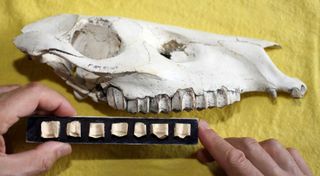From the Horse's Mouth: Teeth Reveal Evolution

A team of paleodentists of sorts has examined fossilized horse teeth from as far as 55.5 million years ago and found a timeline of changing tooth features that matches up with the climate record.
The changing climate was responsible for major changes over time in the horses' diets, which were reflected in their teeth. Researchers were able to follow horses' shift from eating fruit to grazing on grass in response to their shifting environment in North America.
Previous studies used chemical analyses of teeth and microscopic wear to understand what the animals were eating, but because these approaches require such hard work, studies were limited to a few specimens at a time, according to lead researcher Matthew Mihlbachler, an assistant professor of anatomy at the New York College of Osteopathic Medicine.
With a new approach called mesowear that relies on the shape of the tooth, specifically sharpness of the cusps of molars, scientists were able to amass a much larger sample size. The sharpness of the cusps is determined by diet.
"We looked at wear patterns on horse teeth using mesowear through the entire history, from 55 million years ago in North America to the extinction at the end of the last ice age," he said.
The history of horses
Horses originally evolved in North America, but they mysteriously died out here about 10,000 years ago. But not before spreading to other continents. Horses returned to the Americas with European explorers and colonists.
Sign up for the Live Science daily newsletter now
Get the world’s most fascinating discoveries delivered straight to your inbox.
The first horses in North America emerged about 55.5 million years ago. They were small, fox-size animals with four toes and low-crowned teeth. They lived in a warm, moist, forested environment, and the wear on their rounded cusps matches those of fruit-eaters, Mihlbachler said.
Around 33 million years ago, the horses' teeth changed noticeably, with the cusps of a fruit-eater being replaced by the sharper points associated with a diet of leaves. By this time, the rain forests had disappeared and the climate went through a cool spell.
"The signal we are getting in the change in horses' diet is very consistent with what we understand about how the climate was changing," Mihlbachler said.
About 18 million years ago, the teeth of some ancient horses, those most closely related to modern horses, changed markedly. The surface of their molars became more complex and better suited for chewing tough plants, particularly grasses, which contain particles of silica that can wear down teeth. The teeth also began growing taller. [Mystery of Tooth Strength Cracked]
These changes appear to be related to the spread of grasslands, which prompted some horses to add grass to their diets.
"The changes in the teeth are just slightly behind the environment and dietary trends, which is very consistent with the hypothesis of adaptation," Mihlbachler said.
After this, tooth height continued to increase, likely in response to harsher, particularly colder, climate conditionsand the continued spread of grasslands. Horses with less abrasive, leafy diets stayed in the picture for a while, then disappeared about 10 million years ago.
Intermediate diets later disappeared, and the highly abrasive, grassy diets of modern horses have been the norm for the last 4 million to 5 million years, roughly the amount of the time the modern horse has been in existence.
"Certainly, there were leaves and trees throughout all that time period, from 55 million years ago to the extinction. What we don’t know is why horses left those niches," Mihlbachler said.
You can follow LiveScience senior writer Wynne Parry on Twitter @Wynne_Parry.
Most Popular


